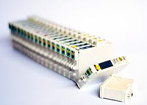 A leader of the One Laptop Per Child project has rejected allegations that the organization 'sold out' by raising prices and allowing Microsoft to run Windows on the machine.
A leader of the One Laptop Per Child project has rejected allegations that the organization 'sold out' by raising prices and allowing Microsoft to run Windows on the machine.
The OLPC, an ultra-low-cost notebook PC aimed at children in developing countries, has long been described as the '$100 laptop'. News emerged earlier this week that it would in fact debut at $175. At the same time, project founder, Nicholas Negroponte said that designers had added an SD memory card slot to enable the OLPC to run Microsoft Windows.
Critics charged the OLPC project with 'selling out', and increasing the cost to accommodate Microsoft's wishes.
One of the OLPC's lead designers, vice president of software, Jim Gettys, refutes these allegations.
The addition of the SD card socket was in fact a minimal expense he claims. In addition, despite the widespread publication of the $100 figure, this is in fact a target price, not the initial price, he says.
“That we always have said '$100 in late 2008-2009', always seems to get lost in the press,” Gettys explains.
Asic and faster chip
Significant changes have been made in the OLPC specification, Getty's concedes. These were made because the initial hardware was too slow to run some of the machine's open source software at an acceptable speed, and it also had problems interfacing to flash memory.
To deal with these performance issues, designers decided to upgrade the CPU and graphics chip from an AMD Geode GX to the more powerful AMD Geode LX. Simultaneously, RAM and flash memory were doubled to 512 MB, and 1GB respectively. OLPC leaders also added a custom ASIC (Application Specific Integrated Circuit) chip to speed flash memory access and other functions.
“The unanimous choice of the launch countries was, though it would cost slightly more initially, that they preferred to have one nicer system over a longer period of time.I was in the room when this decision was taken,” says Gettys, “and it had nothing to do with Microsoft.”
“Some have suggested that we deliberately restrict what software can run on OLPC: this goes fundamentally against the grain of what freedom is,” he says
Read more at Jim Gettys' website.
You might also be interested in Texyt's earlier article on the OLPC: Non-profit OLPC 'will be profitable for some'










About the cost...
From the Newsweek article"The $100 Un-PC" in the February 12, 2007 issue. I have absolutely no legal right to copy this text, please don't sue me.
Excerpt from the main article:
"...Though Negroponte promises he'll meet the $100 mark by the end of 2008, today each XO costs about $140, even with subsidized parts. AMD, for instance, offers its processors and Chi Lin Technology supplies screens at prices below what they charge for-profit companies."
From the inset mini-interview:
Newsweek:How ready are you to start? And will it really cost $100?
Negroponte: We've got them in eight or 10 countries already, being tested. As for price, we'll probably start closer to $150, and then work down.
---
So the cost isn't going up by much, they are not putting Windows on it, and from the article at OLPCnews it seems that they did all they could to keep the cost down.
It also seems that the slot was asked for by the initial launch countries. I thought that was the point: cover poor people's needs for the least dough. Who are we to say what they need when they say otherwise?
Ofcourse you could make a very valid argument here that what they ask is not necessarily what they need. :)
If the OLPC was unable to
If the OLPC was unable to run Windows, that's a weakness. This company is in the hardware business, and it is in the best interest of themselves, and their buyers, to make the hardware compatible with whatever is demanded.
OLPC
1/ Sounds like the OLPC was designed by a committee!
2/ If Windows runs/will run on this platform, Bill will make even more money! He will find a way!